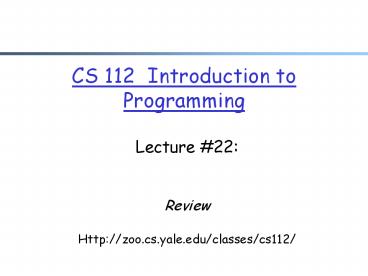CS 112 Introduction to Programming - PowerPoint PPT Presentation
1 / 9
Title:
CS 112 Introduction to Programming
Description:
Location: DL 220 7-9 PM. Office hours today. 2-3pm (AKW 202) ... loop-and-a-half idiom. 6. Classes and Methods. Using a class to create objects ... – PowerPoint PPT presentation
Number of Views:39
Avg rating:3.0/5.0
Title: CS 112 Introduction to Programming
1
CS 112 Introduction to Programming
- Lecture 22
- Review
- Http//zoo.cs.yale.edu/classes/cs112/
2
Admin.
- Midterm one this evening
- Location DL 220 7-9 PM
- Office hours today
- 2-3pm (AKW 202)
- Another time slot before the exam to be posted
on the class page
3
C Data Types
count
t4
- Value (simple) type
- int, char, double, etcA value type variable
stores a value of the type of the variableint x
45double y 45.12 - Reference type
- Class or arrayA reference variable stores a
reference to an object or arrayA reference is a
location in computers memory where the object
or array itself is storedTime3 t1t1 new
Time3(11, 45, 59) - Time3 t2 t1Time3 t4 new Time3(1, 2,
3)t2.SetTime(2, 2, 2)Time3.Count()int a1
1, 2, 3int a2 a1
x
45
y
45.12
t1
t2
a1
a2
4
Simple Data Types
- range and precision of data types
- know what data type to use, e.g., assignment 1
problem 1 - input/output of simple data types Parse()
methods - arithmetic operations
- Result depend on type
- 4/5 0 while 4.0/5 0.8 and (double)4/5 0.8
4/(double)5 0.8 int x (int)Math.Round(
(double)4/ 5 ) - data conversion
- implicit conversion, cast, see examples of
lecture 5 - boolean operations
- operator precedence
- a summary of all operators can be found at Fig.
7.2 or slides of lecture 18.
5
Flow of Control
- conditional statements
- if and if/else statements
- C ternary conditional operator
- switch statement
- loop statements
- while, do/while, and for statements
- break/continue statements
- writing, choosing, and understanding loop
programs, e.g. - loop-and-a-half idiom
6
Classes and Methods
- Using a class to create objects
- an object has state and behavior
- A class definition includes variable and method
definitions - A variable or method can be static or non-static
- A non-static variable also called an instance
variable - A non-static method is also called an instance
method - See StaticTest and other samples.
- A variable or method can be public or private
(default is private) - enforce encapsulation
7
Defining a Method
- Overloading and signature
- Compiler try the best match
- If multiple matches, find the best match
- If no direct match, if implicit conversion is
allowed to match a method, use it. - Variables that can be used in a method
- A static method
- class scope static variables
- Local variables (we also consider formal
arguments as local variables) - An instance method
- Class scope variables (instance or static)
- Local variables
8
Calling a Method
- Each time a method is called, the actual
arguments in the invocation are copied into the
formal arguments - If a value type, then it is the value that is
copied - If a reference type, then it is the reference
that is copied - The formal argument and the actual argument are
different variables, with different memory
locations - However, if an argument of a method is ref (or
out), then the formal argument and the actual
argument are aliases of each other, i.e. they
share the same memory cell
9
Arrays
- array declaration and initialization
- Some examples of arrays command line, string
- some typical designs of using arrays, e.g., using
array elements as counters































